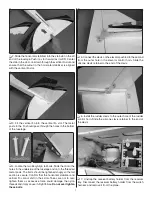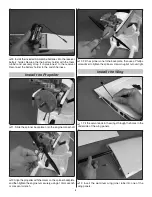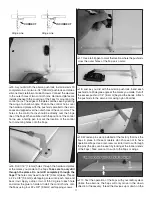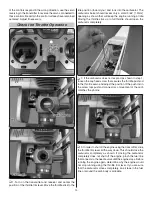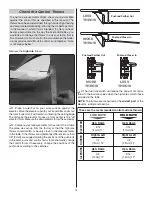
19
speed needle valve at full throttle until an audible drop in RPM
is heard. If checking with a tachometer, the engine should be
run at approximately 200 rpm below the maximum rpm.
ADJUSTING THE MIXTURE
CONTROL VALVE
The mixture control valve is the small slotted screw located
at the end of the carburetor opposite the throttle arm. With
the engine running, close the throttle and allow it to idle for
about fi ve seconds, and then open the throttle fully. If the
engine is slow to pick up and produces an excess of exhaust
smoke, the mixture is too rich. Correct this condition by turning
the mixture control valve clockwise 15-30°. If the mixture is
excessively rich, engine rpm will become unstable. Opening
the throttle will produce a great deal of smoke and rpm may
drop suddenly or the engine may stop. If the mixture is too
lean, you will notice a lack of exhaust smoke and a tendency
for the engine to cut out when the throttle is opened. In this
case, turn the mixture control valve counter-clockwise 90°
to richen the idle mixture, and then turn the valve clockwise
gradually until the engine regains full power cleanly when the
throttle is reopened.
FLYING
Do not attempt to fl y by yourself if you are a beginning
pilot
. The Avistar’s docile fl ying characteristics makes learning
to fl y R/C an easier experience, but the help from an instructor
is invaluable. An instructor is going to be able to inspect your
airplane to make sure everything is working correctly and he
will also be able to give you a few tips and comments on how
to improve your fl ying. Also, make sure you fl y at an AMA
sanctioned fl ying fi eld.
CAUTION
(THIS APPLIES TO ALL R/C AIRPLANES): If,
while fl ying, you notice an alarming or unusual sound such
as a low-pitched “buzz,” this may indicate control surface
fl utter.
Flutter occurs when a control surface (such as an
aileron or elevator) or a fl ying surface (such as a wing or
stab) rapidly vibrates up and down (thus causing the noise).
In extreme cases, if not detected immediately, fl utter can
actually cause the control surface to detach or the fl ying
surface to fail, thus causing loss of control followed by an
impending crash. The best thing to do when fl utter is detected
is to slow the model
immediately
by reducing power, then
land as soon as safely possible. Identify which surface
fl uttered (so the problem may be resolved) by checking all
the servo grommets for deterioration or signs of vibration.
Make certain all pushrod linkages are secure and free of
play. If it fl uttered once, under similar circumstances it will
probably fl utter again unless the problem is fi xed. Some
things which can cause fl utter are; Excessive hinge gap;
Not mounting control horns solidly; Poor fi t of clevis pin in
horn; Side-play of wire pushrods caused by large bends;
Excessive free play in servo gears; Insecure servo mounting;
and one of the most prevalent causes of fl utter; Flying an
over-powered model at excessive speeds.
Taxiing
Before the model is ready for takeoff, it must fi rst be set up
to roll straight down the runway. With the engine running at
a low idle, place the plane on the runway and, if your fl ying
fi eld permits, stand behind the model. Advance the throttle
just enough to allow the model to roll. If the model does not
roll straight down the runway, shut the engine off and adjust
the nose gear pushrod as necessary. Do not use the rudder
trim to correct the nose wheel because this will also affect the
rudder.
Note
: Crosswinds may affect the direction the model
rolls, so this test should be done in calm conditions, or with
the model facing directly into the wind.
Takeoff
It is typical when fl ying with an instructor to allow him or her to
have control during take off and landing for at least your fi rst
couple of fl ights. Allow yourself time to become comfortable
with the sticks in the air before attempting a complete fl ight
on your own if you are a beginning pilot.
If possible, take off directly into the wind. If you are experienced,
taking off in a crosswind is permissible (and sometimes
necessary—depending upon the prevailing wind conditions
and runway heading).Taking off into the wind will help the
model roll straight and also reduces ground speed for takeoff.
Taxi the model onto the runway or have an assistant carry
it out and set it down, pointing down the runway into the
wind. When ready, lower the fl aps (if equipped) and gradually
advance the throttle while simultaneously using the left stick
(rudder/nose wheel) to steer the model. Gain as much speed
as the runway and fl ying site will practically allow before gently
applying up elevator lifting the model into the air. Be ready
to make immediate corrections with the ailerons to keep the
wings level, and be smooth on the elevator stick, allowing
the model to establish a gentle climb to a safe altitude before
making the fi rst turn (away from yourself). Do not “yank” back
the elevator stick forcing the plane into too steep of a climb
which could cause the model to quit fl ying and stall.



